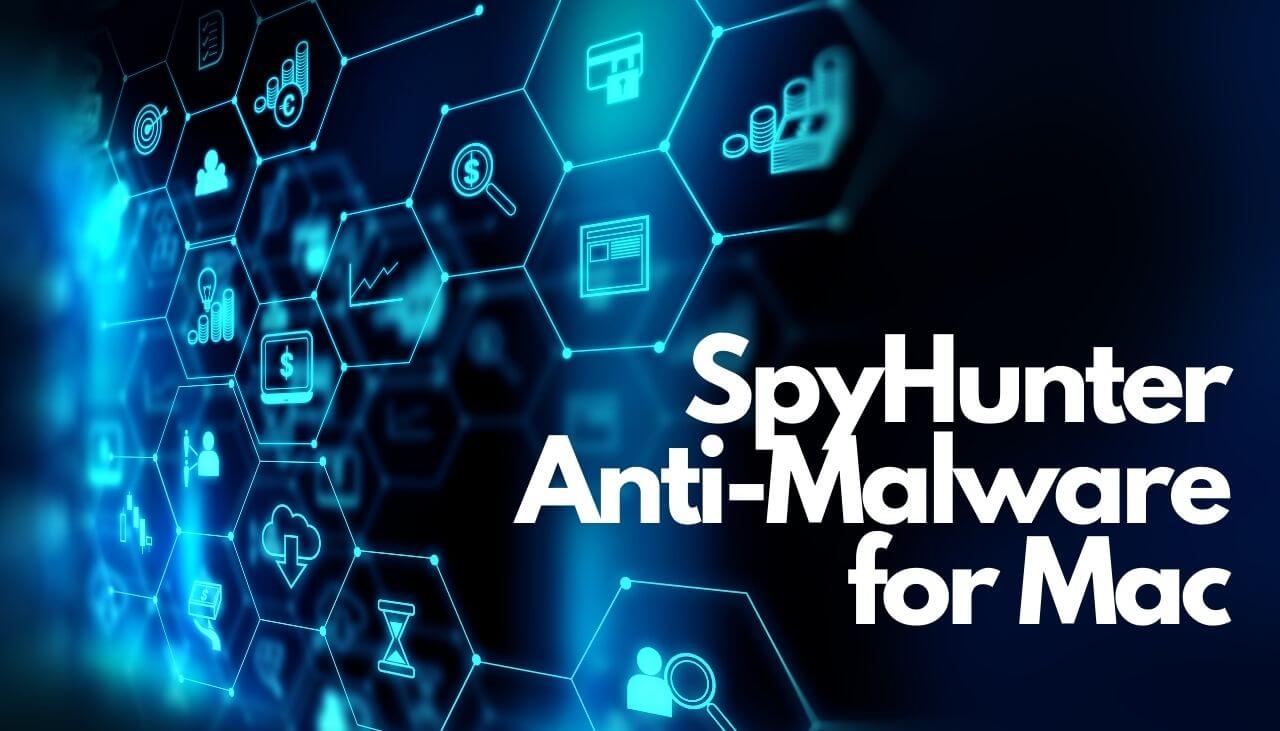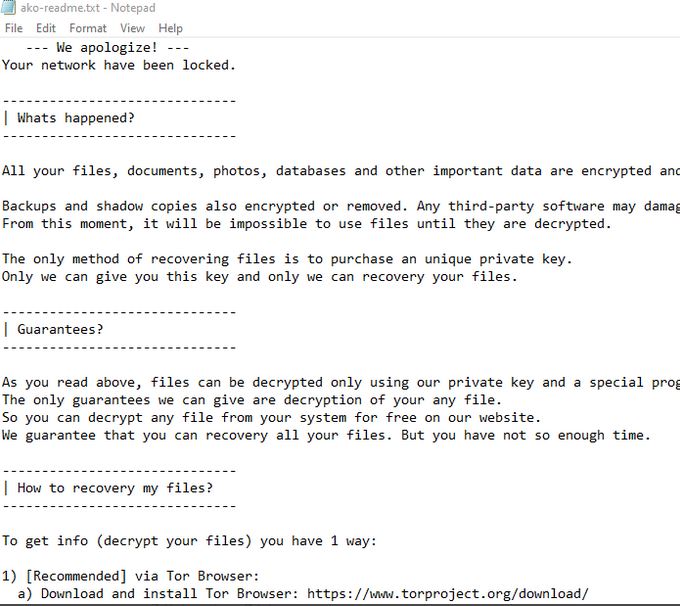The .hj36M virus is a ransomware that is currently set against target end users on a global scale. There is no information available about the hacking group behind it. It is believed to be a new iteration of the famous ransomware family. This is one of the reasons why we believe that the hackers are experienced.
Once the .hj36M virus has started it will execute its built-in sequence of dangerous commands. Depending on local conditions or the specific hacker instructions various actions will take place. The file encryption will begin after them — the encrypting component will use a built-in list of target file type extensions. In the end the victim files will be renamed with the .hj36M extension.

Threat Summary
| Name | hj36M Virus |
| Type | Ransomware, Cryptovirus |
| Short Description | The ransomware encrypts files on your computer machine and demands a ransom to be paid to allegedly restore them. |
| Symptoms | The ransomware will blackmail the victims to pay them a decryption fee. Sensitive user data may be encrypted by the ransomware code. |
| Distribution Method | Spam Emails, Email Attachments |
| Detection Tool |
See If Your System Has Been Affected by malware
Download
Malware Removal Tool
|
User Experience | Join Our Forum to Discuss hj36M Virus. |
| Data Recovery Tool | Windows Data Recovery by Stellar Phoenix Notice! This product scans your drive sectors to recover lost files and it may not recover 100% of the encrypted files, but only few of them, depending on the situation and whether or not you have reformatted your drive. |
The .hj36M virus is a new release of a relatively small ransomware family known as Ako. The active campaign containing this particular release is not large at the moment however we anticipate that a much larger attack may be planned in the near future if the initial infections prove to be successful. Like the ransomware there is not much information available about the hacking group as well.
What we know is that a large part of the samples are released through web attacks which gives out several main distribution tactics. The first and foremost ones that are frequently used by hackers are the typical social engineering tactics — they aim to manipulate the recipients into thinking that they are receiving notifications from a familiar company or service. They can take the forms of either mass-sent email messages or specially made websites. The shown contents is commonly uploaded to sites that are hosted on domain names that are very similar to the real ones.
The .hj36M virus samples can also be integrated in various types of files which can be uploaded on such places. They are macro-infected documents of all popular formats: presentations, text documents, databases and spreadsheets. When opened a prompt will be created asking them to enable the built-in scripts. This will trigger the infection. The other method used by such hackers is to create setup bundles of popular applications which are often installed by end users. All of these files can easily be uploaded to file-sharing network such as BitTorrent where both pirate and legitimate files are found.
The .hj36MM virus can also be delivered to the end target using directed network attacks — they are done by using hacker toolkits that attempt to intrude onto the victim computers by looking for specific weaknesses using exploits.
Due to the small number of captured samples there is not enough information about all possible consequences of a .hj36M virus infection. Some of the possible malware actions are the following:
- Information Gathering and Processioning — This component will generate an unique ID based on the individual hardware characteristics of the infected machine. The hackers usually do this by reporting on the installed parts and may also hijack personal information about the victims. In the end the output of this will be an unique string that is associated with each hijacked computer.
- Additional Threats Installation — The made Ako ransomware infections like this .hj36M virus can be used to install other threats to the affected machines. Popular options include cryptocurrency miners, Trojans and hijackers.
- System Changes — The ransomware can be used to make changes to the user settings, configuration settings and important operating system variables. This can lead to data loss and severe performance issues. Some of the most common issues related to the reconfiguration of the computer will install the .hj36M virus as a persistent threat. This is done by launching it every time the computer is powered on. If the Windows Registry is affected then the virus may create entries for itself or modify already existing ones. This makes it very difficult to remove the active infections.
In the end the encryption phase will be run which will run process target user data according to a new list of files. This is done by encrypting a lot of personal information including archives, backups, documents, multimedia files and etc. The processed files will be renamed with the .hj36MM extension. The victims will be instructed to pay the hackers a set decryption fee in order to recover their data.

Remove .hj36M Virus
If your computer system got infected with the .hj36M Files ransomware virus, you should have a bit of experience in removing malware. You should get rid of this ransomware as quickly as possible before it can have the chance to spread further and infect other computers. You should remove the ransomware and follow the step-by-step instructions guide provided below.
- Step 1
- Step 2
- Step 3
- Step 4
- Step 5
Step 1: Scan for hj36M Virus with SpyHunter Anti-Malware Tool



Ransomware Automatic Removal - Video Guide
Step 2: Uninstall hj36M Virus and related malware from Windows
Here is a method in few easy steps that should be able to uninstall most programs. No matter if you are using Windows 10, 8, 7, Vista or XP, those steps will get the job done. Dragging the program or its folder to the recycle bin can be a very bad decision. If you do that, bits and pieces of the program are left behind, and that can lead to unstable work of your PC, errors with the file type associations and other unpleasant activities. The proper way to get a program off your computer is to Uninstall it. To do that:


 Follow the instructions above and you will successfully delete most unwanted and malicious programs.
Follow the instructions above and you will successfully delete most unwanted and malicious programs.
Step 3: Clean any registries, created by hj36M Virus on your computer.
The usually targeted registries of Windows machines are the following:
- HKEY_LOCAL_MACHINE\Software\Microsoft\Windows\CurrentVersion\Run
- HKEY_CURRENT_USER\Software\Microsoft\Windows\CurrentVersion\Run
- HKEY_LOCAL_MACHINE\Software\Microsoft\Windows\CurrentVersion\RunOnce
- HKEY_CURRENT_USER\Software\Microsoft\Windows\CurrentVersion\RunOnce
You can access them by opening the Windows registry editor and deleting any values, created by hj36M Virus there. This can happen by following the steps underneath:


 Tip: To find a virus-created value, you can right-click on it and click "Modify" to see which file it is set to run. If this is the virus file location, remove the value.
Tip: To find a virus-created value, you can right-click on it and click "Modify" to see which file it is set to run. If this is the virus file location, remove the value.
Before starting "Step 4", please boot back into Normal mode, in case you are currently in Safe Mode.
This will enable you to install and use SpyHunter 5 successfully.
Step 4: Boot Your PC In Safe Mode to isolate and remove hj36M Virus





Step 5: Try to Restore Files Encrypted by hj36M Virus.
Method 1: Use STOP Decrypter by Emsisoft.
Not all variants of this ransomware can be decrypted for free, but we have added the decryptor used by researchers that is often updated with the variants which become eventually decrypted. You can try and decrypt your files using the instructions below, but if they do not work, then unfortunately your variant of the ransomware virus is not decryptable.
Follow the instructions below to use the Emsisoft decrypter and decrypt your files for free. You can download the Emsisoft decryption tool linked here and then follow the steps provided below:
1 Right-click on the decrypter and click on Run as Administrator as shown below:
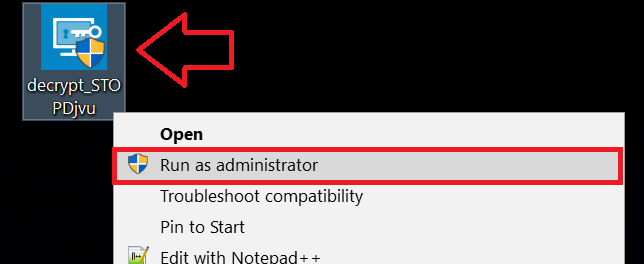
2. Agree with the license terms:
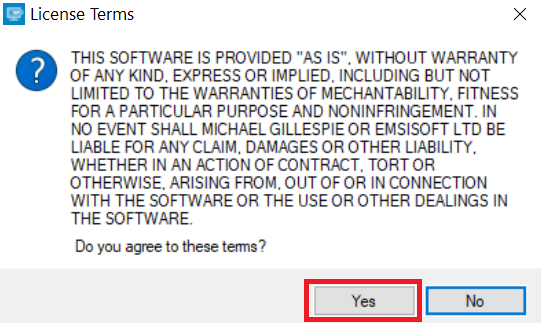
3. Click on "Add Folder" and then add the folders where you want files decrypted as shown underneath:
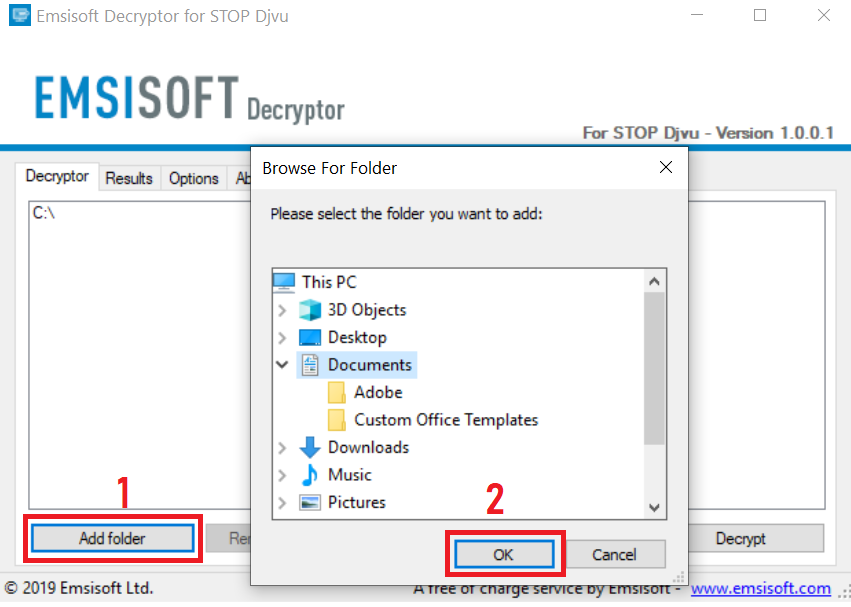
4. Click on "Decrypt" and wait for your files to be decoded.

Note: Credit for the decryptor goes to Emsisoft researchers who have made the breakthrough with this virus.
Method 2: Use data recovery software
Ransomware infections and hj36M Virus aim to encrypt your files using an encryption algorithm which may be very difficult to decrypt. This is why we have suggested a data recovery method that may help you go around direct decryption and try to restore your files. Bear in mind that this method may not be 100% effective but may also help you a little or a lot in different situations.
Simply click on the link and on the website menus on the top, choose Data Recovery - Data Recovery Wizard for Windows or Mac (depending on your OS), and then download and run the tool.
hj36M Virus-FAQ
What is hj36M Virus Ransomware?
hj36M Virus is a ransomware infection - the malicious software that enters your computer silently and blocks either access to the computer itself or encrypt your files.
Many ransomware viruses use sophisticated encryption algorithms to make your files inaccessible. The goal of ransomware infections is to demand that you pay a ransom payment to get access to your files back.
What Does hj36M Virus Ransomware Do?
Ransomware in general is a malicious software that is designed to block access to your computer or files until a ransom is paid.
Ransomware viruses can also damage your system, corrupt data and delete files, resulting in the permanent loss of important files.
How Does hj36M Virus Infect?
Via several ways.hj36M Virus Ransomware infects computers by being sent via phishing emails, containing virus attachment. This attachment is usually masked as an important document, like an invoice, bank document or even a plane ticket and it looks very convincing to users.
Another way you may become a victim of hj36M Virus is if you download a fake installer, crack or patch from a low reputation website or if you click on a virus link. Many users report getting a ransomware infection by downloading torrents.
How to Open .hj36M Virus files?
You can't without a decryptor. At this point, the .hj36M Virus files are encrypted. You can only open them once they are decrypted using a specific decryption key for the particular algorithm.
What to Do If a Decryptor Does Not Work?
Do not panic, and backup the files. If a decryptor did not decrypt your .hj36M Virus files successfully, then do not despair, because this virus is still new.
Can I Restore ".hj36M Virus" Files?
Yes, sometimes files can be restored. We have suggested several file recovery methods that could work if you want to restore .hj36M Virus files.
These methods are in no way 100% guaranteed that you will be able to get your files back. But if you have a backup, your chances of success are much greater.
How To Get Rid of hj36M Virus Virus?
The safest way and the most efficient one for the removal of this ransomware infection is the use a professional anti-malware program.
It will scan for and locate hj36M Virus ransomware and then remove it without causing any additional harm to your important .hj36M Virus files.
Can I Report Ransomware to Authorities?
In case your computer got infected with a ransomware infection, you can report it to the local Police departments. It can help authorities worldwide track and determine the perpetrators behind the virus that has infected your computer.
Below, we have prepared a list with government websites, where you can file a report in case you are a victim of a cybercrime:
Cyber-security authorities, responsible for handling ransomware attack reports in different regions all over the world:
Germany - Offizielles Portal der deutschen Polizei
United States - IC3 Internet Crime Complaint Centre
United Kingdom - Action Fraud Police
France - Ministère de l'Intérieur
Italy - Polizia Di Stato
Spain - Policía Nacional
Netherlands - Politie
Poland - Policja
Portugal - Polícia Judiciária
Greece - Cyber Crime Unit (Hellenic Police)
India - Mumbai Police - CyberCrime Investigation Cell
Australia - Australian High Tech Crime Center
Reports may be responded to in different timeframes, depending on your local authorities.
Can You Stop Ransomware from Encrypting Your Files?
Yes, you can prevent ransomware. The best way to do this is to ensure your computer system is updated with the latest security patches, use a reputable anti-malware program and firewall, backup your important files frequently, and avoid clicking on malicious links or downloading unknown files.
Can hj36M Virus Ransomware Steal Your Data?
Yes, in most cases ransomware will steal your information. It is a form of malware that steals data from a user's computer, encrypts it, and then demands a ransom in order to decrypt it.
In many cases, the malware authors or attackers will threaten to delete the data or publish it online unless the ransom is paid.
Can Ransomware Infect WiFi?
Yes, ransomware can infect WiFi networks, as malicious actors can use it to gain control of the network, steal confidential data, and lock out users. If a ransomware attack is successful, it could lead to a loss of service and/or data, and in some cases, financial losses.
Should I Pay Ransomware?
No, you should not pay ransomware extortionists. Paying them only encourages criminals and does not guarantee that the files or data will be restored. The better approach is to have a secure backup of important data and be vigilant about security in the first place.
What Happens If I Don't Pay Ransom?
If you don't pay the ransom, the hackers may still have access to your computer, data, or files and may continue to threaten to expose or delete them, or even use them to commit cybercrimes. In some cases, they may even continue to demand additional ransom payments.
Can a Ransomware Attack Be Detected?
Yes, ransomware can be detected. Anti-malware software and other advanced security tools can detect ransomware and alert the user when it is present on a machine.
It is important to stay up-to-date on the latest security measures and to keep security software updated to ensure ransomware can be detected and prevented.
Do Ransomware Criminals Get Caught?
Yes, ransomware criminals do get caught. Law enforcement agencies, such as the FBI, Interpol and others have been successful in tracking down and prosecuting ransomware criminals in the US and other countries. As ransomware threats continue to increase, so does the enforcement activity.
About the hj36M Virus Research
The content we publish on SensorsTechForum.com, this hj36M Virus how-to removal guide included, is the outcome of extensive research, hard work and our team’s devotion to help you remove the specific malware and restore your encrypted files.
How did we conduct the research on this ransomware?
Our research is based on an independent investigation. We are in contact with independent security researchers, and as such, we receive daily updates on the latest malware and ransomware definitions.
Furthermore, the research behind the hj36M Virus ransomware threat is backed with VirusTotal and the NoMoreRansom project.
To better understand the ransomware threat, please refer to the following articles which provide knowledgeable details.
As a site that has been dedicated to providing free removal instructions for ransomware and malware since 2014, SensorsTechForum’s recommendation is to only pay attention to trustworthy sources.
How to recognize trustworthy sources:
- Always check "About Us" web page.
- Profile of the content creator.
- Make sure that real people are behind the site and not fake names and profiles.
- Verify Facebook, LinkedIn and Twitter personal profiles.


